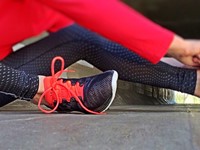Cross training for running sports
BlogImage
by Rob Haddow, RMT, Dip.SIT
Can we get out and run right now? Sure. Does that rule out the possibility of detraining during distancing? Absolutely not.
Sports that involve a lot of running don’t just involve running in a straight line, so hopping onto the sidewalk for a few kilometers isn’t going to really meet the strength and conditioning needs of your average soccer/football/ultimate player.
So what?
Sports that involve lots of running largely require some messy accessory movement as we respond to other players, irregular play surfaces, and sudden changes in direction. Some athletes focus more on agility (multidirectional acceleration/deceleration) while others may cater to speed (high range/acceleration/deceleration in a sagittal plane). As always, the needs for cross training are highly individual, and some people will benefit greatly from focusing on one or two movements, while others will find more value in general mobility or resistance. I’ll try to stay somewhat general in picking from my library of previous remedial exercises, but bear in mind that these movements are hardly exhaustive, and are somewhat focused on novel movement and off-axis exploration to round out your daily running.
Note: As this is an entire kinetic chain, I’ll begin from the ground up for each. Everything can be scaled by changing the range/resistance/rate of activity.
Range Training:
For range training in running sports, we have the obvious demands on flexion/extension at the hip, knee and ankle, but we also have to consider the less obvious rotational demands through the chain, as well as the lumbopelvic complex.
Range exploration from the ground up can begin with BOSU Circles or Tarsal Tilt Exercises as a general exploration of ankle mobility and control. From there we can build with a greater demand on Closed Kinetic Chain Mobility at for knee valgus/varus. Finally, we can add some greater hip mobility with the 90/90 and more spinal involvement to that with Additional Reaching.
Resistance Training:
If we look at most professional athletes in any running sport, we’ll see some characteristic morphology - hypertrophy of the muscles associated with triple extension and triple flexion are pretty hard to miss. Resistance training for running sports is mostly straightforward as long as we include off-axis chain work:
For the ankles, resistance to, and resilience from forced inversion/eversion can be helped with simple band work for inversion/eversion or gradual exposure to Inversion Transitions. Knee resistance can include simple exercises like Nordic Superman Reaches for flexion or Simple Kneeling for extension. Hip strengthening can involve any direction of movement, but I often find Shin Boxes great for rotation and Modified Cossacks for adduction to be very helpful additions to cross train.
Rate Training:
If we think about it, we’re essentially balanced on two bendy lever arms sticking out of our behinds. When you add speed and agility to the mix, the complexity of timing and control makes a lot more sense. This is where any setback in training can become very obvious - go back to a skill that requires precision that you haven’t kept up on, and see how well you fare.
General coordination is key here, Caraocas and Squat Walks can be great all-inclusive exercises, and can be easily modified with increased weight, lateral resistance, reduced vision, or explosive start/stops.
In closing:
Sure, going for a run is going to be great for our conditioning, but it’s important to take the time to focus on the other skills needed in running sports. The above exercises are general, yes, but make for a decent start in maintaining sport-specific capacity.


